Zhiyu Liang
KDSelector: A Knowledge-Enhanced and Data-Efficient Model Selector Learning Framework for Time Series Anomaly Detection
Mar 16, 2025



Abstract:Model selection has been raised as an essential problem in the area of time series anomaly detection (TSAD), because there is no single best TSAD model for the highly heterogeneous time series in real-world applications. However, despite the success of existing model selection solutions that train a classification model (especially neural network, NN) using historical data as a selector to predict the correct TSAD model for each series, the NN-based selector learning methods used by existing solutions do not make full use of the knowledge in the historical data and require iterating over all training samples, which limits the accuracy and training speed of the selector. To address these limitations, we propose KDSelector, a novel knowledge-enhanced and data-efficient framework for learning the NN-based TSAD model selector, of which three key components are specifically designed to integrate available knowledge into the selector and dynamically prune less important and redundant samples during the learning. We develop a TSAD model selection system with KDSelector as the internal, to demonstrate how users improve the accuracy and training speed of their selectors by using KDSelector as a plug-and-play module. Our demonstration video is hosted at https://youtu.be/2uqupDWvTF0.
An Unsupervised Learning Framework Combined with Heuristics for the Maximum Minimal Cut Problem
Aug 16, 2024



Abstract:The Maximum Minimal Cut Problem (MMCP), a NP-hard combinatorial optimization (CO) problem, has not received much attention due to the demanding and challenging bi-connectivity constraint. Moreover, as a CO problem, it is also a daunting task for machine learning, especially without labeled instances. To deal with these problems, this work proposes an unsupervised learning framework combined with heuristics for MMCP that can provide valid and high-quality solutions. As far as we know, this is the first work that explores machine learning and heuristics to solve MMCP. The unsupervised solver is inspired by a relaxation-plus-rounding approach, the relaxed solution is parameterized by graph neural networks, and the cost and penalty of MMCP are explicitly written out, which can train the model end-to-end. A crucial observation is that each solution corresponds to at least one spanning tree. Based on this finding, a heuristic solver that implements tree transformations by adding vertices is utilized to repair and improve the solution quality of the unsupervised solver. Alternatively, the graph is simplified while guaranteeing solution consistency, which reduces the running time. We conduct extensive experiments to evaluate our framework and give a specific application. The results demonstrate the superiority of our method against two techniques designed.
TimeCSL: Unsupervised Contrastive Learning of General Shapelets for Explorable Time Series Analysis
Apr 07, 2024


Abstract:Unsupervised (a.k.a. Self-supervised) representation learning (URL) has emerged as a new paradigm for time series analysis, because it has the ability to learn generalizable time series representation beneficial for many downstream tasks without using labels that are usually difficult to obtain. Considering that existing approaches have limitations in the design of the representation encoder and the learning objective, we have proposed Contrastive Shapelet Learning (CSL), the first URL method that learns the general-purpose shapelet-based representation through unsupervised contrastive learning, and shown its superior performance in several analysis tasks, such as time series classification, clustering, and anomaly detection. In this paper, we develop TimeCSL, an end-to-end system that makes full use of the general and interpretable shapelets learned by CSL to achieve explorable time series analysis in a unified pipeline. We introduce the system components and demonstrate how users interact with TimeCSL to solve different analysis tasks in the unified pipeline, and gain insight into their time series by exploring the learned shapelets and representation.
Unsupervised Multi-modal Feature Alignment for Time Series Representation Learning
Dec 09, 2023



Abstract:In recent times, the field of unsupervised representation learning (URL) for time series data has garnered significant interest due to its remarkable adaptability across diverse downstream applications. Unsupervised learning goals differ from downstream tasks, making it tricky to ensure downstream task utility by focusing only on temporal feature characterization. Researchers have proposed multiple transformations to extract discriminative patterns implied in informative time series, trying to fill the gap. Despite the introduction of a variety of feature engineering techniques, e.g. spectral domain, wavelet transformed features, features in image form and symbolic features etc. the utilization of intricate feature fusion methods and dependence on heterogeneous features during inference hampers the scalability of the solutions. To address this, our study introduces an innovative approach that focuses on aligning and binding time series representations encoded from different modalities, inspired by spectral graph theory, thereby guiding the neural encoder to uncover latent pattern associations among these multi-modal features. In contrast to conventional methods that fuse features from multiple modalities, our proposed approach simplifies the neural architecture by retaining a single time series encoder, consequently leading to preserved scalability. We further demonstrate and prove mechanisms for the encoder to maintain better inductive bias. In our experimental evaluation, we validated the proposed method on a diverse set of time series datasets from various domains. Our approach outperforms existing state-of-the-art URL methods across diverse downstream tasks.
Contrastive Shapelet Learning for Unsupervised Multivariate Time Series Representation Learning
Jun 02, 2023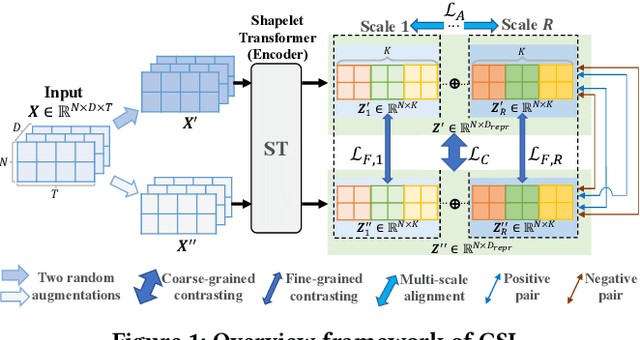

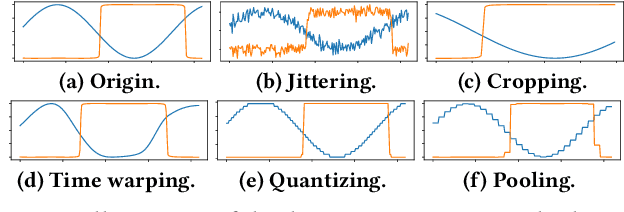
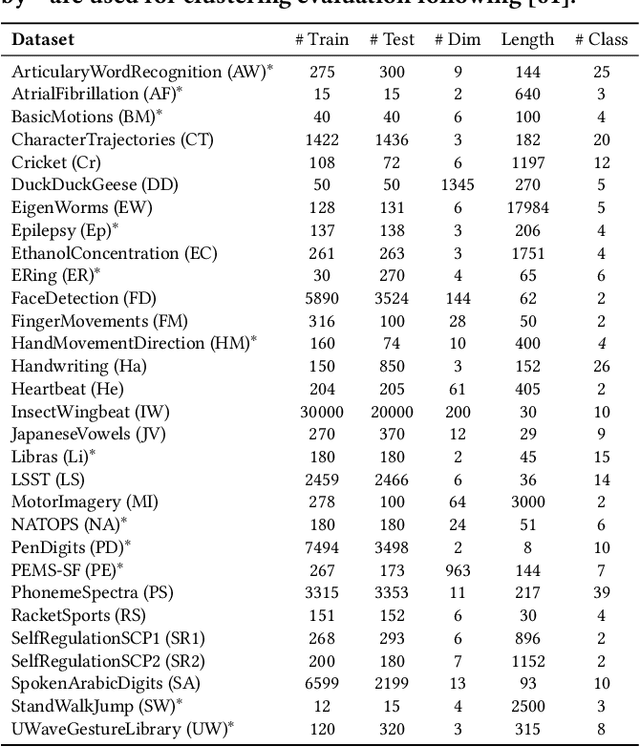
Abstract:Recent studies have shown great promise in unsupervised representation learning (URL) for multivariate time series, because URL has the capability in learning generalizable representation for many downstream tasks without using inaccessible labels. However, existing approaches usually adopt the models originally designed for other domains (e.g., computer vision) to encode the time series data and rely on strong assumptions to design learning objectives, which limits their ability to perform well. To deal with these problems, we propose a novel URL framework for multivariate time series by learning time-series-specific shapelet-based representation through a popular contrasting learning paradigm. To the best of our knowledge, this is the first work that explores the shapelet-based embedding in the unsupervised general-purpose representation learning. A unified shapelet-based encoder and a novel learning objective with multi-grained contrasting and multi-scale alignment are particularly designed to achieve our goal, and a data augmentation library is employed to improve the generalization. We conduct extensive experiments using tens of real-world datasets to assess the representation quality on many downstream tasks, including classification, clustering, and anomaly detection. The results demonstrate the superiority of our method against not only URL competitors, but also techniques specially designed for downstream tasks. Our code has been made publicly available at https://github.com/real2fish/CSL.
TodyNet: Temporal Dynamic Graph Neural Network for Multivariate Time Series Classification
Apr 11, 2023Abstract:Multivariate time series classification (MTSC) is an important data mining task, which can be effectively solved by popular deep learning technology. Unfortunately, the existing deep learning-based methods neglect the hidden dependencies in different dimensions and also rarely consider the unique dynamic features of time series, which lack sufficient feature extraction capability to obtain satisfactory classification accuracy. To address this problem, we propose a novel temporal dynamic graph neural network (TodyNet) that can extract hidden spatio-temporal dependencies without undefined graph structure. It enables information flow among isolated but implicit interdependent variables and captures the associations between different time slots by dynamic graph mechanism, which further improves the classification performance of the model. Meanwhile, the hierarchical representations of graphs cannot be learned due to the limitation of GNNs. Thus, we also design a temporal graph pooling layer to obtain a global graph-level representation for graph learning with learnable temporal parameters. The dynamic graph, graph information propagation, and temporal convolution are jointly learned in an end-to-end framework. The experiments on 26 UEA benchmark datasets illustrate that the proposed TodyNet outperforms existing deep learning-based methods in the MTSC tasks.
UniTS: A Universal Time Series Analysis Framework with Self-supervised Representation Learning
Mar 24, 2023Abstract:Machine learning has emerged as a powerful tool for time series analysis. Existing methods are usually customized for different analysis tasks and face challenges in tackling practical problems such as partial labeling and domain shift. To achieve universal analysis and address the aforementioned problems, we develop UniTS, a novel framework that incorporates self-supervised representation learning (or pre-training). The components of UniTS are designed using sklearn-like APIs to allow flexible extensions. We demonstrate how users can easily perform an analysis task using the user-friendly GUIs, and show the superior performance of UniTS over the traditional task-specific methods without self-supervised pre-training on five mainstream tasks and two practical settings.
FedST: Privacy Preserving Federated Shapelet Transformation for Interpretable Time Series Classification
Mar 02, 2023Abstract:This paper studies how to develop accurate and interpretable time series classification (TSC) models with the help of external data in a privacy-preserving federated learning (FL) scenario. To the best of our knowledge, we are the first to study on this essential topic. Achieving this goal requires us to seamlessly integrate the techniques from multiple fields including Data Mining, Machine Learning, and Security. In this paper, we formulate the problem and identify the interpretability constraints under the FL setting. We systematically investigate existing TSC solutions for the centralized scenario and propose FedST, a novel FL-enabled TSC framework based on a shapelet transformation method. We recognize the federated shapelet search step as the kernel of FedST. Thus, we design $\Pi_{FedSS-B}$, a basic protocol for the FedST kernel that we prove to be secure and accurate. Further, we identify the efficiency bottlenecks of the basic protocol and propose optimizations tailored for the FL setting for acceleration. Our theoretical analysis shows that the proposed optimizations are secure and more efficient. We conduct extensive experiments using both synthetic and real-world datasets. Empirical results show that our FedST solution is effective in terms of TSC accuracy, and the proposed optimizations can achieve three orders of magnitude of speedup.
The Geometry of Nonlinear Embeddings in Kernel Discriminant Analysis
May 12, 2020



Abstract:Fisher's linear discriminant analysis is a classical method for classification, yet it is limited to capturing linear features only. Kernel discriminant analysis as an extension is known to successfully alleviate the limitation through a nonlinear feature mapping. We study the geometry of nonlinear embeddings in discriminant analysis with polynomial kernels and Gaussian kernel by identifying the population-level discriminant function that depends on the data distribution and the kernel. In order to obtain the discriminant function, we solve a generalized eigenvalue problem with between-class and within-class covariance operators. The polynomial discriminants are shown to capture the class difference through the population moments explicitly. For approximation of the Gaussian discriminant, we use a particular representation of the Gaussian kernel by utilizing the exponential generating function for Hermite polynomials. We also show that the Gaussian discriminant can be approximated using randomized projections of the data. Our results illuminate how the data distribution and the kernel interact in determination of the nonlinear embedding for discrimination, and provide a guideline for choice of the kernel and its parameters.
Low-Power Computer Vision: Status, Challenges, Opportunities
Apr 15, 2019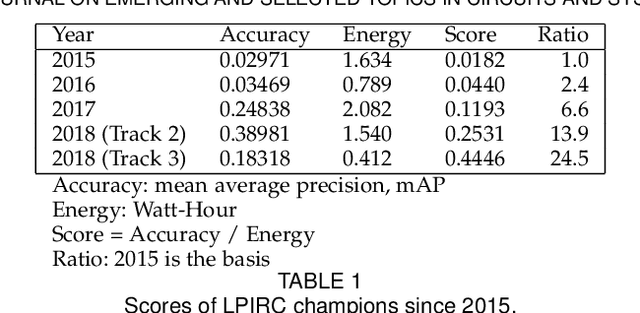
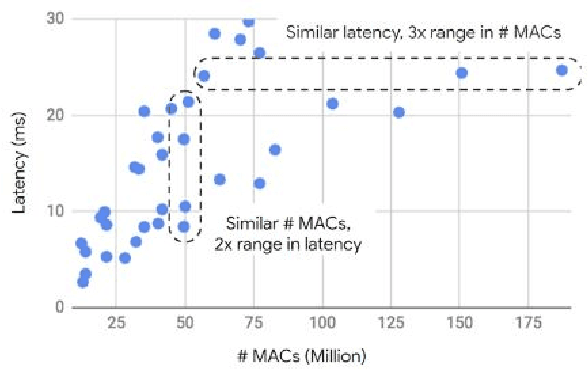
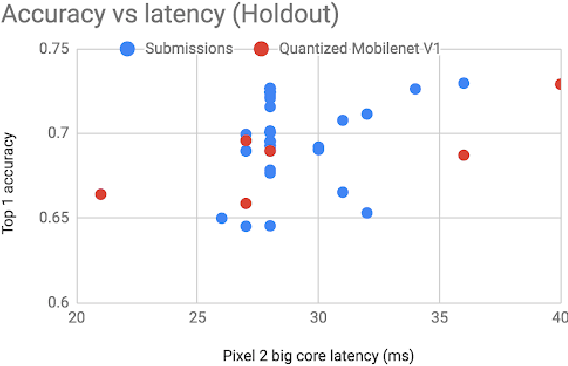
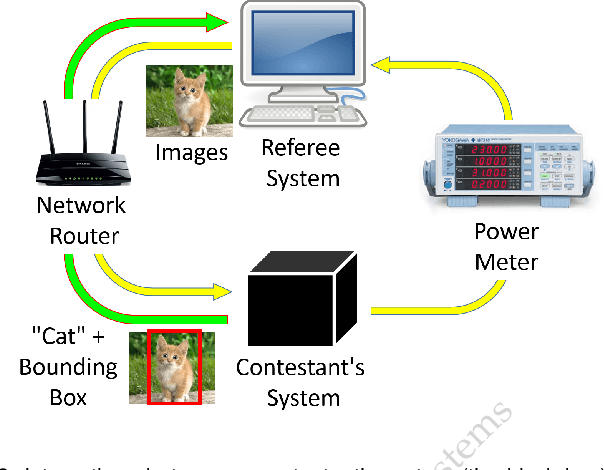
Abstract:Computer vision has achieved impressive progress in recent years. Meanwhile, mobile phones have become the primary computing platforms for millions of people. In addition to mobile phones, many autonomous systems rely on visual data for making decisions and some of these systems have limited energy (such as unmanned aerial vehicles also called drones and mobile robots). These systems rely on batteries and energy efficiency is critical. This article serves two main purposes: (1) Examine the state-of-the-art for low-power solutions to detect objects in images. Since 2015, the IEEE Annual International Low-Power Image Recognition Challenge (LPIRC) has been held to identify the most energy-efficient computer vision solutions. This article summarizes 2018 winners' solutions. (2) Suggest directions for research as well as opportunities for low-power computer vision.
 Add to Chrome
Add to Chrome Add to Firefox
Add to Firefox Add to Edge
Add to Edge